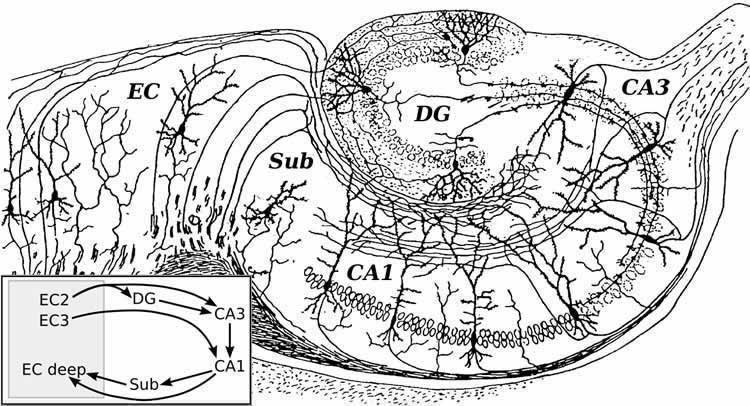Summary: Researchers report that by increasing the excitability of a subpopulation of hippocampal inhibitory neurons, certain behavioral symptoms associated with schizophrenia can be suppressed.
Source: University of Geneva.
Schizophrenia, an often severe and disabling psychiatric disorder, affects approximately 1% of the world’s population. While research over the past few years has suggested that desynchronization of neurons may be the cause of its neuropsychiatric symptoms, such as memory disorders, hyperactivity or hallucinatory phenomena, the cellular origin of such desynchronization remains poorly understood. Today, a decisive step in understanding this disease has been taken. Researchers at the University of Geneva (UNIGE) have succeeded not only in deciphering a cellular mechanism leading to the desynchronization of neural networks, but also in correcting this organizational defect in an adult animal model, thereby suppressing abnormal behaviours associated with schizophrenia. Results, to be discovered in Nature Neuroscience, that show that a therapeutic intervention is possible at all ages.
Schizophrenia, which clinical manifestations may differ from one patient to another, is a neurodevelopmental disease characterized by many cognitive and behavioural symptoms, including visual or auditory hallucinations, memory and planning issues, or hyperactivity. While the exact cause of this highly disabling disease is not yet known, certain genetic mutations greatly increase its risk. For example, individuals affected by the DiGeorge syndrome are 40 times more likely to develop schizophrenic disorders than the general population. The DiGeorge syndrome, also known as the 22q11 deletion syndrome, is a human genetic abnormality marked by the absence of about thirty genes on one of the two copies of chromosome 22.
“What happens in the brains of patients suffering from these behavioural changes characteristic of the disease? Our aim was not only to understand how their neural networks dysfunctions, but also to figure out whether it was possible to restore their normal functioning, especially in adults,” explains Alan Carleton, professor in the Department of Basic Neurosciences at the Faculty of Medicine of the UNIGE, who directed this work.
A question of networks
The Geneva neuroscientists chose to focus on neural networks of the hippocampus, a brain structure notably involved in memory. They studied a mouse model that reproduces the genetic alteration of DiGeorge syndrome as well as some behavioural changes associated with schizophrenia. In the hippocampus of a control mouse, the thousands of neurons that make up the network coordinate according to a very precise sequence of activity, which is dynamic in time and synchronized. However, in the neural networks of their mouse models, the scientists observed something completely different: the neurons showed the same level of activity as in control animals, but without any coordination, as if these cells were incapable of communicating properly with each other. “The organization and synchronization of neural networks is achieved through the intervention of subpopulations of inhibitory neurons, including parvalbumin neurons,» says Carleton. “However, in this animal model of schizophrenia, these neurons are much less active. Without proper inhibition to control and structure the electrical activity of other neurons in the network, anarchy rules. ”
Restoring neural order, even in adulthood
The second step was to try to restore the synchronization necessary for neural networks to function properly. To do this, the scientists specifically targeted the parvalbumin neurons of the hippocampus. By stimulating these dysfunctional inhibitory neurons, they managed to restore the sequential organization and normal functioning of neural networks. Similarly, they were able to correct some behavioural abnormalities in these schizophrenia mouse models, suppressing both hyperactivity and memory deficit.

These very positive results suggest that a therapeutic intervention is possible, even in adulthood. “This is really essential. Indeed, schizophrenia develops in late adolescence, although the neural alterations are most likely present since the neurodevelopmental stage. According to our results, reinforcing the action of a poorly active inhibitory neuron, even after the brain has developed, could be sufficient to restore the proper functioning of these neural networks, thus making certain pathological behaviours disappear.”
Current treatments for schizophrenia are primarily based on the administration of antipsychotic drugs targeting the dopaminergic and serotoninergic systems. In spite of their positive effect on hallucinatory symptoms, they remain less effective to improve many symptoms, and in particular cognitive symptoms. An approach aiming at overcoming the defect of parvalbumin neurons to increase their inhibitory effect therefore appears to be a promising target; nevertheless, time will be needed before a treatment based on this strategy is developed. The neuroscientists now want to confirm their results by extending their research to schizophrenia resulting from genetic alterations different from those of DiGeorge syndrome.
Source: Alan Carleton – University of Geneva
Publisher: Organized by NeuroscienceNews.com.
Image Source: NeuroscienceNews.com image is in the public domain.
Original Research: Abstract for “Restoring wild-type-like CA1 network dynamics and behavior during adulthood in a mouse model of schizophrenia” by Thomas Marissal, Rodrigo F. Salazar, Cristina Bertollini, Sophie Mutel, Mathias De Roo, Ivan Rodriguez, Dominique Müller & Alan Carleton in Nature Neuroscience. Published September 17 2018.
doi:10.1038/s41593-018-0225-y
[cbtabs][cbtab title=”MLA”]University of Geneva”Resynchronizing Neurons to Erase Schizophrenia.” NeuroscienceNews. NeuroscienceNews, 17 September 2018.
<https://neurosciencenews.com/schizophrenia-neuron-resynch-9876/>.[/cbtab][cbtab title=”APA”]University of Geneva(2018, September 17). Resynchronizing Neurons to Erase Schizophrenia. NeuroscienceNews. Retrieved September 17, 2018 from https://neurosciencenews.com/schizophrenia-neuron-resynch-9876/[/cbtab][cbtab title=”Chicago”]University of Geneva”Resynchronizing Neurons to Erase Schizophrenia.” https://neurosciencenews.com/schizophrenia-neuron-resynch-9876/ (accessed September 17, 2018).[/cbtab][/cbtabs]
Abstract
Restoring wild-type-like CA1 network dynamics and behavior during adulthood in a mouse model of schizophrenia
Schizophrenia is a severely debilitating neurodevelopmental disorder. Establishing a causal link between circuit dysfunction and particular behavioral traits that are relevant to schizophrenia is crucial to shed new light on the mechanisms underlying the pathology. We studied an animal model of the human 22q11 deletion syndrome, the mutation that represents the highest genetic risk of developing schizophrenia. We observed a desynchronization of hippocampal neuronal assemblies that resulted from parvalbumin interneuron hypoexcitability. Rescuing parvalbumin interneuron excitability with pharmacological or chemogenetic approaches was sufficient to restore wild-type-like CA1 network dynamics and hippocampal-dependent behavior during adulthood. In conclusion, our data provide insights into the network dysfunction underlying schizophrenia and highlight the use of reverse engineering to restore physiological and behavioral phenotypes in an animal model of neurodevelopmental disorder.






